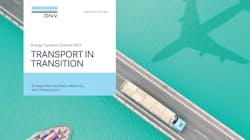DNV: 'Operators have only two options to achieve decarbonization'
By Ariana Hurtado, Editor and Director of Special Reports
DNV recently released its latest "Transport in Transition" report that stated oil demand in the transport sector (road, aviation and maritime) will half by 2050.
"Driven by the decarbonization push, the fuel mix in the maritime sector will also change significantly over the coming decades," the report stated. "By 2050 it will likely transition from being almost entirely oil-based to an energy mix comprising of 50% low- and zero-carbon fuels, 19% natural gas and 18% biomass. Electricity will obtain only a 4% share, from short sea shipping and port stays for larger vessels."
In this Q&A, Thomas Horschig, senior researcher, Energy Transition at DNV, shares more decarbonization insights with Offshore.
OFFSHORE: What does the fuel mix in the maritime sector look like in the near future, say in the next five to 10 years?
The coming years will see increased uptake of electricity for shore power and close to shore operations (e.g. ferry operations), while for international shipping, there will be biofuels and a diverse mix of low carbon fuels such as methanol and ammonia. Despite the increasing uptake of electricity, biofuels and hydrogen based low carbon fuels, and looking at total contributions to the sector, the next five to 10 years in the maritime sector are dominated by fossil fuels.
OFFSHORE: How did you obtain these offshore fuel mix outlook numbers, and can you briefly explain some of the variables at play?
HORSCHIG: The basis for our forecast, and thus the numbers presented, is a combination of two approaches. Firstly, our "Energy Transition Outlook Model," an integrated system-dynamics simulation model that reflects relationships between demand and supply in several interconnected modules and, secondly, a dedicated fuel cost model operated by our Maritime Business Area. A combination of the two led to our fuel mix outlook.
OFFSHORE: What should offshore oil and gas operators, offshore service providers and/or offshore wind developers know about your transport outlook or be prepared for as we approach second-half 2023 and move into 2024?
HORSCHIG: Oil use will halve to 2050, which, on one hand, reflects the strong decarbonization in the transport sector, mainly driven by decarbonization of road transport and, on the other, the consisting oil use in transport to mid-century.
However, there is ongoing and mounting pressure to decarbonize transport for environmental, health and energy security reasons. Given the enduring relevance of oil and gas in end-use applications, operators have only two options to achieve decarbonization: either decarbonize their own operations or adapt their infrastructure to produce low- or zero-carbon fuels.
For upstream producers, the potential decarbonization actions are widely recognized, including more efficient production, transitioning to alternative power sources (e.g., electricity), reducing fugitive emissions and flaring, and increasing the use of carbon capture, utilization and storage (CCUS). Downstream operators, meanwhile, can pursue energy efficiency, low-carbon and renewable hydrogen instead of conventional grey hydrogen, synthetic fuels and sustainable feedstocks such as biomass, biological or atmospheric CO2 for the production of e-fuels.
Offshore wind operators need to have in mind that the strong electrification of road transport, and the stronger embedding of e-fuels starting from the 2030s, require huge amounts of electricity, and thus huge amounts of offshore wind, especially in Europe.
OFFSHORE: What emissions challenges does the offshore transport industry face?
HORSCHIG: Transportation presents a unique challenge in reducing greenhouse-gas (GHG) emissions due to its distributed nature. Unlike a steel plant, which can implement carbon capture and storage (CCS) at the source to reduce emissions, decarbonizing transportation is much more difficult and perhaps even impossible in this regard, although there are pilot programs for onboard CCS in ships.
Nonetheless, it could still play a valuable role in reducing GHG emissions if other carbon-neutral fuels are not available. However, CCS cannot be applied to aircraft, nor to the more than 1 billion vehicles on the road. To decarbonize transportation, we need a range of solutions such as liquid sustainable carbon fuels derived from biomass, renewable electricity, and sustainable CO2 and water. Unfortunately, low feedstock availability and low value chain efficiencies significantly limit their use.
Editor's note: More insights to the decarbonization challenge and future fuel mix of the maritime sector will be further detailed in DNV's "Maritime Forecast to 2050," which will be available September 2023. Additionally, a more detailed view on renewable electricity development, and offshore wind prospects in detail, will be presented in the next update of DNV's "Energy Transition Outlook," to be published in October 2023.
05.11.2023
About the Author
Ariana Hurtado
Editor-in-Chief
With more than a decade of copy editing, project management and journalism experience, Ariana Hurtado is a seasoned managing editor born and raised in the energy capital of the world—Houston, Texas. She currently serves as editor-in-chief of Offshore, overseeing the editorial team, its content and the brand's growth from a digital perspective.
Utilizing her editorial expertise, she manages digital media for the Offshore team. She also helps create and oversee new special industry reports and revolutionizes existing supplements, while also contributing content to Offshore's magazine, newsletters and website as a copy editor and writer.
Prior to her current role, she served as Offshore's editor and director of special reports from April 2022 to December 2024. Before joining Offshore, she served as senior managing editor of publications with Hart Energy. Prior to her nearly nine years with Hart, she worked on the copy desk as a news editor at the Houston Chronicle.
She graduated magna cum laude with a bachelor's degree in journalism from the University of Houston.


